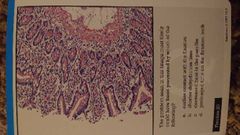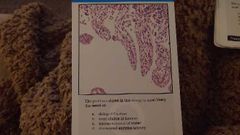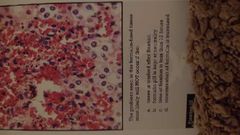![]()
![]()
![]()
Use LEFT and RIGHT arrow keys to navigate between flashcards;
Use UP and DOWN arrow keys to flip the card;
H to show hint;
A reads text to speech;
41 Cards in this Set
- Front
- Back
|
What term describes glyoxal? |
Aldehyde. Glyoxal is an aldehyde that may be used as a fixative. Both aliphatic and aromatic hydrocarbons are used as clearing agents. Xylene is an aromatic hydrocarbon. Alcohols end in ol as in ethanol and not in Al. |
|
|
Paraformaldehyde is a polymer of what? |
Formaldehyde. ParaFormaldehyde can be depolymerized to yield formaldehyde solutions that do not contain methanol. Paraldehyde is a controlled substance used in the preparation of aldehyde fuchsin. Acetaldehyde (which is not a controlled substance) may be used to prepare aldehyde fuchsin instead of paraldehyde. |
|
|
What amount of commercial stock formaldehyde solution is present in 450 ml of 10% formalin? |
45% ml of commercial stock formaldehyde solution is present. 10% formalin is a 1:10 dilution of commercial stock formaldehyde solutions. |
|
|
Tissue that is well fixed in 10% neutral buffered formalin will demonstrate: A. Good fixation of lipids B. Lysis of red blood cells C. Stabilization of protiens D. Increased enzyme activity |
Stabilization of protiens. Main purpose of fixation is the stabilization of protiens. One of purposes of fixation is to prevent autolysis, the result of enzymatic activity. Other answers not correct as formaldehyde does not fox lipids, does not lyse red blood cells, but it does stop enzyme activity. If fixation and preservation of lipids is desired than an osmium tetroxide fixative should be used. Fixatives containing acetic acid will lyse red cells, but nbf does not contain acetic acid. |
|
|
If microwave fixation is used, the maximum temperature must be no higher than: |
68 Celsius If temp allowed to go above 68*c the tissue will show pyknotic, overstained nuclei. There may also be loss of antigenicity and lysis of red cells. |
|
|
Non-coagulant describes which of the following fixative ingredients? A. Mercuric chloride B. Picric acid C. Formaldehyde D. Zinc salts |
C. Formaldehyde Formaldehyde is a non coagulant, but mercuric chloride, picric acid, and zinc salts are all coagulants. |
|
|
Describe the effect on cells of: 1. Hypotonic fixative 2. Hypertonic fixative 3. Isotonic fixative |
1. Water from a hypotonic fixative will be drawn into the cell in an effort to equalize the tonicity. This will cause swelling and possible rupture of cell membrane. 2. Water will be drawn from cell by hypertonic fixative in an attempt to equalize the tonicity. This will cause shrinkage of cell. 3. Isotonic fixatives will neither shrink nor swell the cell. |
|
|
If desired l, formulin pigment may be removed from tissue sections by treating with: A. Running water B. Potassium permanganate C. Alcoholic iodine D. Alcoholic picric acid |
D. Alcoholic picric acid. An alcoholic solution saturated w picric acid is commonly used to remove formalin pigment. Iodine followed by sodium thiosulfate is used to remove mercury pigment, and potassium permanganate Is used to bleach melanin pigment. Running water will not remove any of these pigments. |
|
|
A fresh tumor specimen is sampled for electron microscopy and put into fixative for transportation to the laboratory early the next morning. To what thickness should the sample be cut for good fixation for electron microscopy? |
Tissue Specimens for electron microscopy should be cut no more than 1 mm in thickness or diced into very small 1 mm cubes. |
|
|
What is the choice of fixative for electron specimens to be held overnight before transportation to electron microscopy lab? |
Modified millonig fixative which can be used for both light and electron microscopy studies. Another option, Zamboni paf fixative made of phosphate buffered paraformaldehyde, penetrates rapidly and stabilizes organelles y protiens. Gluteraldehyde used for no longer than 2-4 hrs. Osmium tetroxide should only be used as a secondary fixative for retention of phospholipid in cell membranes |
|
|
Michael transport medium, used for transporting unfixed biopsies, especially for immunofluorescence studies, consists of a buffered solution saturated with: A. Magnesium sulfate B. Ammonium sulfate C. N-ethylmaleimide D. Citric acid |
Ammonium sulfate 1 liter MTM contains 412.3 grams to of ammonium sulfate. Magnesium sulfate, n-ethylmaleimide, and citric acid are all components of Michael but used in very small quantities. The large amount of ammonium sulfate in the solution is useful for fixing or immobilizing tissue immunoglobulins. N-ethylmaleimide limits proteolytic activity. MTM should be kept at a pH of 7.0-7.2 for best results. |
|
|
List 3 non-additive fixative ingredients |
1. Acetone 2. Acetic acid 3. Alcohols are non additive fixative ingredients |
|
|
The recommended ratio of fixative to tissue is: A. 1:2 B. 1:20 C. 20:1 D. 2:1 |
C. 20:1 20 volumes of fixative should be used to adequately fix tissue. This a ratio of 15:1 or 20:1. 1 volume of fixative to 2 volumes of tissue, 1 volume of fixative to 20 volumes of tissue, and 2 volumes of fixative to 1 volume of tissue would not provide enough fixative to fix the tissue. |
|
|
Which of the following fixatives does not contain an aldehyde? A. Bouin B. Zamboni C. Helly D. Zenker |
Zenker Bouin, Zamboni, and Helly fixatives all contain formaldehyde. |
|
|
List the ingredients in Bouin fixative. |
Formaldehyde Picric acid Acetic acid |
|
|
Which of the following fixative solutions does not contain mercuric salts? A. Helly B. B-5 C. Orth D. Zenker |
Orth Only contains potassium dichromate, sodium sulfate, and formaldehyde. |
|
|
Methyl alcohol is often substituted for ethyl alcohol in which of the following fixative solutions? A. Carnoy B. Clark C. Bouin D. Hollande |
Carnoy. Known as methacarn. Bouin and Hollands do not contain alcohol. |
|
|
How are Helly and Zenker solutions alike and different? |
Alike: both contain potassium dichromate and mercuric chloride. Differ: Helly contains formaldehyde and Zenker contains acetic acid. |
|
|
H&e stained sections show marked lysis of the red blood cells. Fixation in which of the following could cause this? A. 10 nbf B. Bouin solution C. Zinc formulin D. B-5 |
Bouin solution. The acetic acid in Bouin solution will cause lysis of the red blood cells. None of the other fixatives contains acids so the red blood cells will not be lysed w their use. |
|
|
A specimen suspected of gout is brought to the lab. The fixative ingredients of choice for some of the tissue sections is: A. Orth solution B. 10 nbf C. Absolute alcohol D. Hollande solution |
Absolute alcohol The other fixatives listed are aqueous fixatives and would not preserve urate crystals because they are soluble in aqueous fixatives. |
|
|
Acetic acid is added to some fixatives because of which of the following effects on tissue? A. Softening B. Swelling C. Shrinkage D. Additive |
Swelling. Acetic acid swells tissue and is added to some fixatives to counteract the shrinking effect of another ingredient. |
|
|
List 3 ingredients in Carnoy solution. How does this differ from methacarn? |
Ethyl alcohol, acetic acid, and chloroform. Methacarn contains methyl alcohol, acetic acid and chloroform. |
|
|
Which of the following ingredients is common in Bouin, Hollande, gender, and Zamboni solutions? A. Acetic acidB.Copper acetateC. Picric acidD. Alcohol |
Picric acid. Picric acid.Zamboni does not have acetic acid, only Hollande has copper acetate, only gender contains alcohol. Picric acid.Zamboni does not have acetic acid, only Hollande has copper acetate, only gender contains alcohol. Picric acid.Zamboni does not have acetic acid, only Hollande has copper acetate, only gender contains alcohol. Zamboni does not have acetic acid, only Hollande has copper acetate, only gender contains alcohol. |
|
|
H&e sections of liver reveal marked shrinkage. Which of the following primary fixatives could have caused this? A. Alcohol B. Nbf C. Bouin solution D. Glyoxal |
Alcohol. |
|
|
Overhardened tissue is noted when embedding and sectioning. Which could have caused it? A. Delay in beginning fixation B. Prolonged time of fixation C. Shortened time of dehydration D. Incomplete clearing |
Prolonged time of fixation. A delay in beginning fixation will cause autolysis. Prolonged dehydration may cause over hardening, but shortened dehydration will not. Incomplete clearing will not cause overhardening. |
|
|
Formaldehyde primarily adds on to tissue protiens at which of the following groups? A. -cooh B. -sh C. -oh D. -NH2 |
Nh2. This eventually causes formation of a methylene bridge. |
|
|
Breast biopsies to be used for her2 testing must be fixed for how long? |
Incisional and excisional biopsies used for her2 testing should be fixed in 10 NFB for a minimum of atleast 6 hours and max 48 hrs. |
|
|
Define the following and relate them to formaldehyde Pel Stel Action level |
1.Pel is the permissible exposure limit over an 8 hour period and is 0.75 ppm for formaldehyde. 2. Stel is the short term exposure limit and is 3 ppm over a 15 minute period for formaldehyde. 3. Action level may be defined as the working level over an 8 hour period and is 0.5 ppm for formaldehyde w no further monitoring required |
|
|
List 3 fixative ingredients that can cause pigment formation during fixation or processing. How is each removed? |
Formaldehyde, mercuric salts, alcohol. Formulin pigment (black acid hematin) is removed by a saturated alcohol solution of picric acid or 100 ml 70% alcohol containing 3ml of ammonium hydroxide. Mercuric pigments can be removed by iodine followed by sodium thiosulfate. Chromate pigments, caused by contact w alcohol following incomplete washing after fixation, can be prevented by thorough washing before alcohol contact...it cannot be removed. |
|
|
Tissue fixed in Bouin solution and stored for months reveals very poor staining. The most likely cause of this problem is that the picric acid... A. Contained too much water B. Was not neutralized before ether tissue was processed C. Added to the tissue D. Coagulated the tissue protiens |
Was not neutralized before ether tissue was processed, the staining characteristics will change over time. Picric acid can be washed out and neutralized w alcohol containing lithium carbonate. A saturated picric acid solution is used in the preparation of Bouin solution, so water in the preparation of Bouin solution, so water would not matter. Picric acid is an additive fixative and a coagulant of tissue protiens and this will not cause long-term problems. |
|
|
One of the major uses of acetic acid in fixatives is the precipitation and preservation of .. A. Nucleoprotiens B. Lipids C. Erythrocytes D. Carbohydrates |
Nucleoprotiens. The reaction w lipids and carbohydrates is nil. Erythrocytes are lysed by acetic acid. |
|
|
Identify the preferred fixative for each of the following.. 1. Trichrome stains 2. Pheochromocytoma 3. Urate crystals 4. Ptah 5. Enzyme stains on muscle biopsies |
1. Bouin 2. Orth 3. Absolute alcohol 4. Zenker 5. None, frozen sections should be used. |
|
|
Microwave fixation is an example of: |
Microwave fixation occurs by heat, a physical method of fixation. Chemical methods of fixation employ chemical reagents to stop the enzymatic processes. Dessication is a physical method but does not use microwaves. Enzymes ar enjoy used for fixation, the purpose of fixation is to stop enzymatic activity. |
|
|
Which of the following is a coagulant fixative ingredient? |
Zinc salts or compounds are coagulants. Formaldehyde, glyoxal, and osmium tetroxide are non coagulants. |
|
|
Which of the following cellular elements is most affected by fixation in 10% nbf: A. Nucleic acids B. Lipids C. Protiens D. Carbohydrates |
Protiens. nbf both a additive and non-coagulant fixative that binds to side chains of amino ácidos that contain reactive hydrogen. Lipids are preserved by nbf but not rendered insoluble and are completely removed by exposure to alcohols and xylenes during processing. Formulin has no affect on carbs but when protiens are fixed/stabilized the carbs content inside them are trapped. |
|
|
Frozen section slides cut from fresh, unfixed tissue specimens are optimally fixed in which of the following solutions? A. 37%-40% formaldehyde B. Cold acetone C. Acetic acid alcohol D. Alcoholic formalin |
All solutions mentioned at egood fixatives for frozen sections. But concentrated formaldehyde for 20-30 seconds yields morphologic preservation more like that in permanent sections. Cut frozen sections should be put into fixative immediately. Delay in doing so will result in poor morphology and staining. |
|
|
Is zinc sulfate or zinc chloride preferred for use in zinc formalin? |
Zinc sulfate Zinc chloride is corrosive and could ruin processors |
|
|
Pathologists are most familiar w the morphology and staining patterns produced by formulin fixation. T or F |
True. Most pathologist we're trained in labs using formalin solutions for fixation. |
|

|
Earlier contact w the fixative. |
|

|
Delayed fixation. The loss of epithelium is indicative of delayed fixation, the choice of fixative would not cause this. Water is removed during the dehydration step and excessive shrinkage, not the loss of tissue structures, occurs if the tissue is overdehydrated. The changes seen in this image indicate increased enzymatic activity due to delayed fixation. |
|

|
Formulin ph kept at nuetrality. Formulin pigment forms when pH of the solution drops below 6. Other acidic fixatives containing formaldehyde, such Bouin solution, may also produce formulin pigment. The pigment is the result of the action of an acidic solution of formaldehyde acting on tissues rich in blood, it has been noted also in tissues containing large amounts of blood even w fixation in more nuetral formulin solutions. Les than 12 hours of fixation, washing after fixation, and increased formulin concentration will not decrease the formation of this pigment. |

